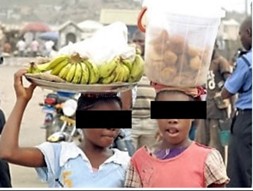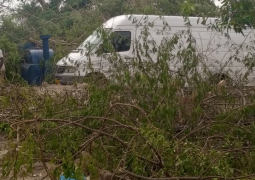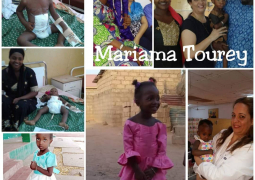
On the same street corner, a girl with a tray of bananas balances her load with practised ease. She is just fourteen, but her eyes are already weary. She smiles at passersby, but her voice carries a quiet urgency: “Buy from me, please.” For her, every dalasi means food at home and another day her mother and younger brother can survive.
To commuters, this is a familiar sight. To the children, it is a life sentence. What looks like simple vending is, in reality, a dangerous bargain: their safety, education, and childhood traded for survival.
Childhood and Street Vending
Child street vending is not new in The Gambia, but experts warn it is worsening. UNICEF estimates that 28 percent of Gambian children aged five to seventeen are in child labour, nearly half of them in hazardous work. The International Labour Organization (ILO) stresses that vending in busy streets is among the riskiest forms of child labour, exposing children to traffic accidents, harassment, and exploitation.
In urban areas, boys often shine shoes, push wheelbarrows, or haul heavy goods, while girls dominate fruit, water, and snack vending. In rural Gambia, children are absorbed into farming, fishing, or lumbering. But in cities like Banjul, Serrekunda, and Brikama, the visibility of child vendors is stark and growing.
The Ministry of Basic and Secondary Education reports that in Greater Banjul, one in five school-age children from low-income households is either out of school or at risk of dropping out. For girls, the consequences are harsher: data shows girls withdrawn for labour are three times less likely than boys to return to school, leaving them vulnerable to early marriage, domestic work, and exploitation.
Case Study One: Mariama’s Dream Deferred (not real name)
At Westfield, 13-year-old Mariama sells cold water in the blazing sun. She once loved school, especially mathematics, but left when her mother could no longer afford uniforms and lunch.
“I want to be a nurse one day,” she said softly. “But when I see my friends in uniform passing by, I feel left behind.”
Her earnings barely cover rice and cooking oil. Each passing day stretches her dream of education further out of reach.
Teachers on the Frontline
A teacher said the impact is painfully obvious in classrooms. “Children are falling behind because they are tired, absent, or distracted by the burden of vending,” explained Michelle Famo Mendy, senior mistress at St. Therese’s Lower Basic School. “Some sleep in class after long nights selling. Others disappear entirely. Beyond academics, they are at risk of theft, drugs, and sexual abuse. Girls especially become targets. How do you teach a child who spends her nights on the street instead of in a home?”
Her words echo across schools where teachers find themselves both educators and first responders to poverty.
Case Study Two: Lamin’s Injury (not real name)
In Serrekunda Market, 14-year-old Lamin pushes a wheelbarrow heavy with sacks of rice. Last month, he slipped while hauling goods and injured his ankle. With no money for treatment, he wrapped the wound in cloth and returned to work the next day.
“I don’t like this work, but if I stop, my brothers and sisters won’t eat,” he said.
Doctors warn children like Lamin risk long-term musculoskeletal damage. Their bodies, still developing, are not built for such labour. What begins as daily survival can end in lifelong disability.
Parliament Raises Alarm
Hon. Modou Lamin Bah, Member of Parliament for Banjul North, says Gambians should be alarmed.
“When we see children vending in traffic, in markets, at night, we should know something is fundamentally broken,” he said. “These are students who belong in classrooms, not in wheelbarrows or in the middle of traffic. If we normalize this, we are writing off our future.”
Bah argues that the legal framework exists, the Labour Act sets the minimum working age at 16, while the Children’s Amendment Act of 2016 prohibits economic exploitation under 18. “The challenge is not law but enforcement. Government must step up, but communities must also hold themselves accountable. Parents need support, yes, but also awareness. You cannot mortgage your child’s future for today’s bread.”
The Hidden Scars of Exploitation
While the physical risks of vending injuries, exploitation, accidents are visible, the psychological scars are often ignored.
Dr Stef Sylva, at Bundung Maternal and Child Hospital, sees the effects in her clinic.
“These children carry adult responsibilities at a tender age,” she said. “We see chronic anxiety, depression, low self-esteem, and in some cases post-traumatic stress. Many vendors are harassed, insulted, or even assaulted on the streets. They internalize this trauma and carry it for life. It affects their learning, their relationships, and their future parenting. The damage is generational.”
Globally, one in seven adolescents suffers a mental health disorder, according to the WHO. But Gambian activists estimate as many as four in ten child vendors show signs of untreated psychological distress.
Case Study Three: A Parent’s Dilemma
In a cramped compound in Serrekunda, Fatou Jarju, a widowed mother of four, explained why her eldest daughter sells oranges at the market.
“I know it is not good, but what else can I do? My husband is gone, I have no work. My daughter helps me so her brothers can eat. If I stop her, they will sleep hungry,” she said, tears filling her eyes.
Her story is repeated in thousands of households, where poverty forces parents into penal choices.
An Activist’s Challenge
One child rights activist, Fatoumatta Sanneh was blunt about government responsibility.
“The Ministry of Gender and Children is failing Gambian children,” the activist said. “We have laws, but where is the enforcement? Where are the inspectors removing children from vending? Where is the support for single mothers? Every year, reports are launched, speeches are made, but children are still in the streets. If officials’ children were the ones selling at traffic lights, would we still be here debating?”
The activist urged Gambians to stop normalizing child vending as “just poverty.” “This is exploitation,” she insisted. “And until we call it that, we will not solve it.”
A Nation at Crossroads
Social worker Mariama Cham calls the situation urgent. “When children are forced into vending, they are stripped of their rights. We cannot wait until they become broken adults. The cost of mental illness, unemployment, crime will be far greater than the cost of intervention.”
The statistics are sobering: nearly one in three Gambian children is in labour. One in five urban poor children is at risk of dropping out of school. Experts say up to 40 percent of street vendors show untreated psychological distress.
For entrepreneur Aminata Coker, the answer remains simple. “The best place for a child is in school, not in the streets. If we fail them, we fail ourselves.”
Searching for Solutions
Despite the grim reality, there are glimpses of hope. NGOs such as ChildFund The Gambia and Save the Children have launched community-based child protection committees that track at-risk children and reintegrate them into school. Some communities have piloted microfinance support for mothers, providing alternatives so families do not rely on child income.
In Senegal, a government-backed “School for All” initiative reduced child street vending by linking free school meals with strict bans on child labour. Education experts suggest The Gambia could adopt a similar model.
Grassroots efforts are also emerging. In Brikama, a group of volunteers run evening literacy classes for child vendors. “If we can’t get them into school during the day, at least we give them a chance to learn at night,” said one volunteer.
Hon. Modou Lamin Bah believes these small efforts must be scaled up. “The solutions exist in support for parents, stronger enforcement, community accountability. What is missing is political will. If we put children first, the resources will follow.”
The Future at Stake
Every child on the streets is a reminder of a choice The Gambia must make: tolerate exploitation or invest in the future.
Until that choice is made, children like Mariama and Lamin will remain in traffic, trading bananas, water, and peanuts for survival, while their childhoods and the nation’s promise slip further out of reach.





